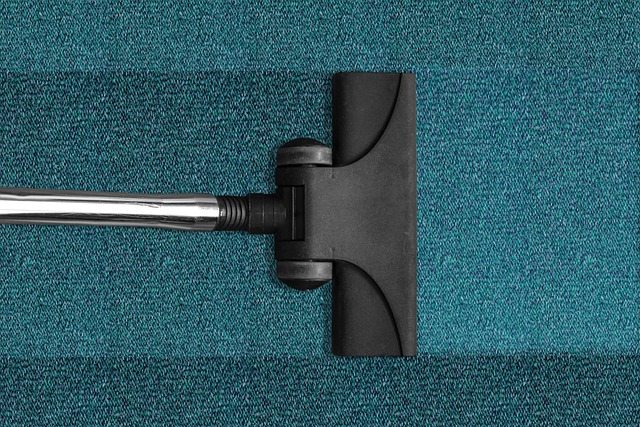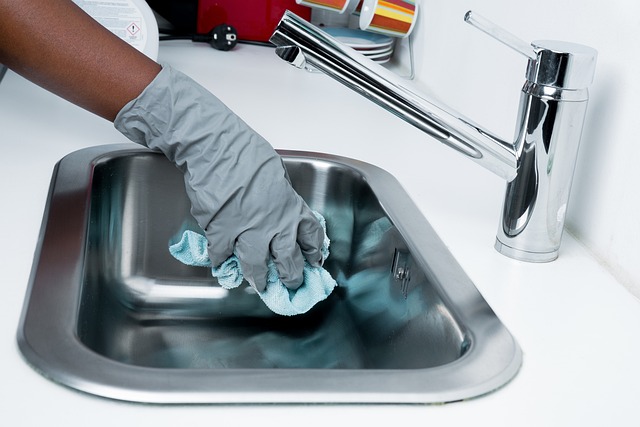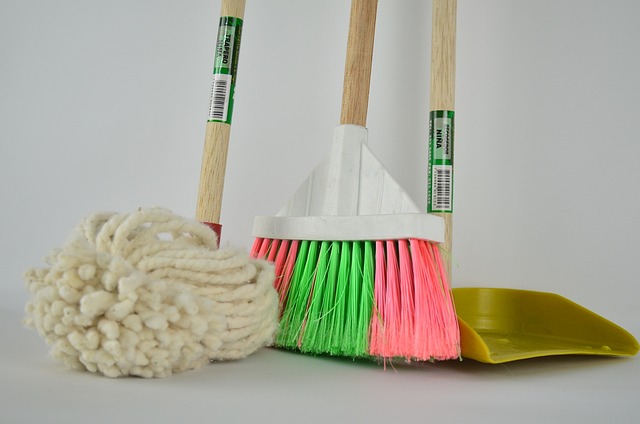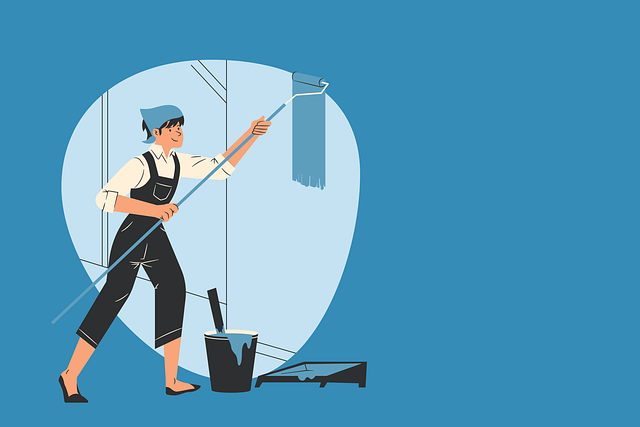Deep cleaning is vital for businesses aiming to create a healthy, productive work environment. It involves targeted sanitization beyond regular cleaning, focusing on hard-to-reach areas like vents, baseboards, and desks to reduce germ transmission. Preparation includes decluttering, organizing, and gathering cleaning supplies, while communication with colleagues ensures minimal disruptions. This process not only enhances aesthetics but also boosts air quality and employee morale by eliminating allergens and germs. Regular deep cleaning of common touchpoints like electronics, door handles, and kitchen appliances is crucial, along with addressing walls, ceilings, and windows to maintain a visually appealing workspace. Ongoing daily hygiene practices, coupled with periodic deep cleans, create a safe, comfortable environment that enhances well-being and productivity.
In today’s shared workspace environments, deep cleaning goes beyond routine maintenance. It’s a comprehensive, intensive process crucial for maintaining a healthy, productive office space. This article guides you through every step of deep cleaning your office, from preparing and gathering essential tools to tackling common areas, electronics, walls, and windows. Discover best practices for responsible disposal, post-clean upkeep, and the profound benefits regular deep cleaning brings to employee well-being.
Understanding the Need for Deep Cleaning in Offices

Maintaining a clean and sanitised office space is essential for any business to thrive. While regular cleaning routines keep surfaces presentable, deep cleaning goes beyond the surface level to address hidden dirt and germs that can accumulate over time. This comprehensive process involves rigorous cleaning techniques and often specialised equipment to eliminate bacteria, viruses, and allergens, ensuring a healthier environment for employees.
Deep Cleaning is especially crucial in offices due to the high foot traffic and shared spaces. It targets hard-to-reach areas, such as vents, baseboards, and desks, which regular cleaners might overlook. By thoroughly disinfecting these zones, businesses can reduce the risk of illness transmission among staff, boost morale, and create a more welcoming atmosphere for clients and visitors.
Preparing for a Comprehensive Office Deep Clean

Before beginning any deep cleaning process, it’s crucial to prepare for a comprehensive office deep clean. This involves several steps that ensure an efficient and effective clean-up. Start by decluttering your workspace, removing all unnecessary items and organizing documents. This not only makes cleaning easier but also creates a more organized environment. Next, gather all the required cleaning supplies, including disinfectant wipes, sponges, vacuum cleaners, and dusting tools. Make sure these are of high quality to ensure optimal sanitization and hygiene.
In addition, inform your colleagues about the deep clean schedule to avoid disruptions. Set aside specific time slots for cleaning to minimize interference with work. It’s also beneficial to communicate any areas that require special attention due to high traffic or sensitive equipment. This preparation ensures a smooth and thorough deep cleaning process, leaving your office space refreshed and hygienic.
Essential Tools and Equipment for Efficient Deep Cleaning

Tackling Common Areas: Desks, Chairs, and Floors

When deep cleaning offices, common areas like desks, chairs, and floors require special attention. Desks and chairs accumulate dust and bacteria from frequent use, so a thorough wipe-down with disinfectant is essential. Use microfiber cloths or brushes to reach nooks and crannies, ensuring every surface is free from grime. For floors, start by sweeping or vacuuming to remove loose debris, then mop using a suitable cleaner tailored for hard floors. This dual approach not only enhances aesthetics but also promotes a healthier environment for employees.
Regular cleaning routines often overlook these areas, so deep cleaning provides an opportunity to restore them to their best condition. Properly maintained desks and chairs contribute to improved productivity and comfort, while sparkling floors create a welcoming atmosphere. Remember that first impressions matter, and a clean office space can significantly impact employee morale and customer perceptions.
Cleaning Electronic Equipment and Surfaces

Deep cleaning offices involves more than just dusting surfaces and vacuuming floors; it means tackling often-overlooked areas like electronic equipment and screens. These items accumulate dirt, grime, and bacteria throughout the day as employees work, making regular wiping down essential for maintaining a healthy environment. Invest in microfiber cloths and static-free sprays to prevent scratching or electrostatic damage while effectively removing dust and smudges from keyboards, mice, monitors, and other devices.
Don’t forget to clean the screens of computers, tablets, and smartphones as well. Use a screen cleaner specifically designed for electronics to avoid damaging the delicate surfaces. Pay close attention to common touchpoints like door handles, light switches, and shared kitchen appliances, frequently disinfecting them with EPA-registered disinfectants to inhibit the spread of germs among employees. A thorough deep cleaning regimen that includes these essential steps will create a healthier, more productive workspace.
Restoring Office Spaces: Walls, Ceilings, and Windows

Deep cleaning is an essential aspect of maintaining a healthy and productive office environment, especially in spaces that see high foot traffic. When it comes to restoring office areas, walls, ceilings, and windows often require extra attention due to their constant exposure to dirt, dust, and various contaminants. A thorough deep clean involves more than just wiping down surfaces; it entails removing built-up grime, cleaning hard-to-reach areas, and ensuring every nook and cranny is sanitized.
Walls accumulate dust and marks from everyday activities, while ceilings can harbor allergens and pollutants. Deep cleaning techniques include scrubbing walls to remove stains and using specialized equipment to reach high areas. Ceilings should be thoroughly wiped down and inspected for any damage or holes, which may require repairs. Windows, often overlooked, gather dust and fingerprints, affecting natural light and view. A meticulous clean ensures they are free from streaks and smears, enhancing the overall aesthetic of the office space.
Managing Disposal and Recycling Responsibly

When conducting deep cleaning for offices, managing disposal and recycling responsibly is a key aspect that cannot be overlooked. This involves categorizing and sorting materials to ensure they are disposed of or recycled in an eco-friendly manner. Start by identifying items like paper, plastic, glass, metal, and electronic waste. Implement proper sorting stations throughout the office to facilitate this process. Educate employees on the importance of responsible disposal and provide clear signage to ensure everyone knows where to place different types of waste.
Regularly schedule recycling pick-ups and establish partnerships with reputable recycling companies to guarantee that materials are processed according to environmental standards. Additionally, consider implementing a composting program for organic waste if feasible. By embracing these practices, you contribute to a cleaner environment while promoting a culture of sustainability within your workplace, making it an integral part of your deep cleaning routine.
Post-Deep Clean Maintenance Tips for Sustained Hygiene

After a deep cleaning, maintaining office hygiene involves consistent daily practices. Regular wiping down of high-touch surfaces like desks, doorknobs, and light switches with disinfectant wipes is crucial to prevent the buildup of germs. Encouraging employees to adopt good personal hygiene habits, such as frequent handwashing and using sanitizers, adds an extra layer of protection.
Designating specific cleaning areas and scheduling regular deep cleans at intervals, for example, weekly or bi-weekly, ensures a clean and safe environment. This routine maintenance, combined with proper waste management practices, will help sustain a hygienic office space, contributing to the overall well-being and productivity of the workforce.
Benefits of Regular Deep Cleaning for Employee Well-being

Regular deep cleaning of offices has far-reaching benefits, especially for employee well-being. It goes beyond the immediate aesthetic improvements; a clean workspace significantly reduces the presence of allergens and germs, creating a healthier environment. This is particularly important in shared spaces where employees spend a significant portion of their day, reducing the risk of illness and improving overall comfort.
Moreover, a tidy office can boost morale and productivity. Cluttered spaces can contribute to mental fatigue, making it harder for employees to focus. By contrast, a clean and organized environment fosters a sense of order and calm, allowing individuals to concentrate better and collaborate more effectively. Thus, deep cleaning is not just an administrative task but a strategic investment in the happiness and output of your workforce.
